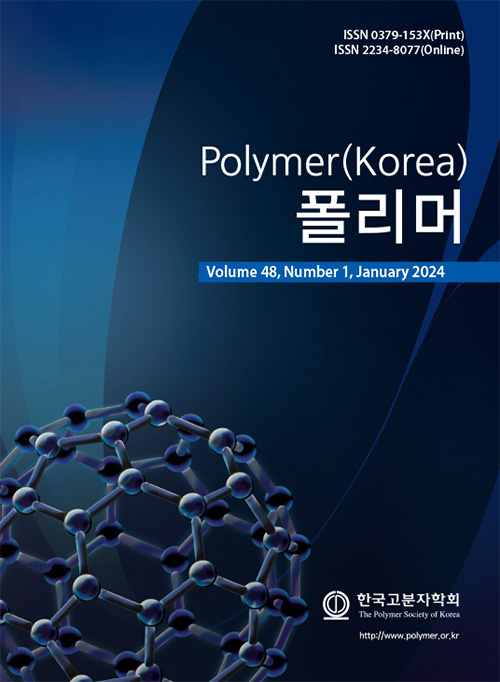- Influence of Polycaprolactone/Collagen Ratio and Microstructure of Fibrous Membranes on Mechanical Properties and Anti-Platelet Properties
Jia-Shuai Zhang*,#, Hui-Lin Mo*,#, Shun-Yang Shen*,#, Du-Han Zhang*, Wei Zhang*, **,†
 , Yu Ren*, **,†
, Yu Ren*, **,†  , and Mei-Xian Li*, **,†
, and Mei-Xian Li*, **,† 
*School of Textile and Clothing, Nantong University, Nantong 226019, China
**National and Local Joint Engineering Research Center of Technical Fiber Composites for Safety and Protection, Nantong University, Nantong 226019, China- Polycaprolactone/Collagen 비율과 섬유 막의 미세 구조가 기계적 특성 및 항혈소판 특성에 미치는 영향 연구
Reproduction, stored in a retrieval system, or transmitted in any form of any part of this publication is permitted only by written permission from the Polymer Society of Korea.
In this paper, polycaprolactone (PCL)/collagen (COL) nanofibrous membranes were prepared by electrospinning to study their mechanical properties as well as biocompatibility. The surface morphology was characterized by scanning electron microscopy (SEM) to access the effect of microstructure on the mechanical properties, cytocompatibility, and enzymatic degradation behaviors. In addition, the effect of hydrophilicity of membranes on the antithrombotic properties was also investigated. The results show that tensile strength of PCL/COL10 is higher than that of other samples due to smaller fiber diameters and tight spatial interlacing of PCL/COL10 membranes. In addition, the hydrophobic surface of PCL becomes hydrophilic after the addition of collagen, which affect platelet adhesion and cytocompatibility of nanofibrous membrane samples. The addition of collagen could promote the cell proliferation as well as the enzymatic degradation rate. Overall, PCL/COL10 has good morphology, the best mechanical properties, appropriate degradation rate, and the best antithrombotic effect as well as biocompatibility.
Keywords: polycaprolactone, collagen, electrospinning, nanofibrous membrane, biocompatibility, antithrombosis.
- Polymer(Korea) 폴리머
- Frequency : Bimonthly(odd)
ISSN 0379-153X(Print)
ISSN 2234-8077(Online)
Abbr. Polym. Korea - 2022 Impact Factor : 0.4
- Indexed in SCIE
 This Article
This Article
-
2024; 48(1): 20-26
Published online Jan 25, 2024
- 10.7317/pk.2024.48.1.20
- Received on Aug 8, 2023
- Revised on Oct 24, 2023
- Accepted on Nov 13, 2023
 Correspondence to
Correspondence to
- Wei Zhang*, ** , Yu Ren*, ** , and Mei-Xian Li*, **
-
*School of Textile and Clothing, Nantong University, Nantong 226019, China
**National and Local Joint Engineering Research Center of Technical Fiber Composites for Safety and Protection, Nantong University, Nantong 226019, China - E-mail: zhangwei@ntu.edu.cn, ren.y@ntu.edu.cn,









 Copyright(c) The Polymer Society of Korea. All right reserved.
Copyright(c) The Polymer Society of Korea. All right reserved.